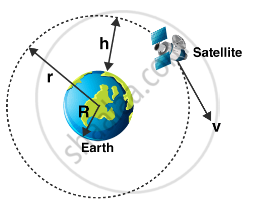Advertisements
Advertisements
प्रश्न
Is it possibe for a body to have inertia but no weight?
उत्तर
The weight of a body is the force with which it is attracted towards the centre of earth. When a body is stationary with respect to the earth, its weight equals gravity. This weight of the body is known as its static or true weight.
Inertia is a property of mass. Hence, a body can have inertia (i.e., mass) but no weight. Everybody always has inertia but its weight (mg) can be zero when it is taken at the centre of the earth or during free fall under gravity or a body placed at a very large distance from the earth. Basically, the weight of a body can be zero when acceleration due to gravity is zero, that condition is called weightlessness.

For example, When a satellite revolves in its orbit around the earth: Weightlessness possess many serious problems for astronauts. It becomes quite difficult for them to control their movements. Everything in the satellite has to be kept tied down. They can be displaced due to their inertia. The creation of artificial gravity is the answer to this problem
APPEARS IN
संबंधित प्रश्न
Consider earth satellites in circular orbits. A geostationary satellite must be at a height of about 36000 km from the earth's surface. Will any satellite moving at this height be a geostationary satellite? Will any satellite moving at this height have a time period of 24 hours?
A spacecraft consumes more fuel in going from the earth to the moon than it takes for a return trip. Comment on this statement.
Choose the correct option.
The binding energy of a satellite revolving around the planet in a circular orbit is 3 × 109 J. It's kinetic energy is ______.
Derive an expression for the critical velocity of a satellite.
The ratio of energy required to raise a satellite of mass 'm' to a height 'h' above the earth's surface of that required to put it into the orbit at same height is ______.
[R = radius of the earth]
There is no atmosphere on moon because ____________.
Reason of weightlessness in a satellite is ____________.
A geostationary satellite is orbiting the earth at the height of 6R above the surface of earth. R being radius of earth. The time period of another satellite at a height of 2.5 R from the surface of earth is ____________.
If a body weighing 40 kg-wt is taken inside the earth to a depth to `1/2` th radius of the earth, then the weight of the body at that point is ____________.
The period of revolution of a satellite is ______.
